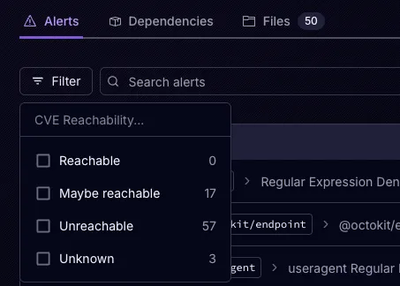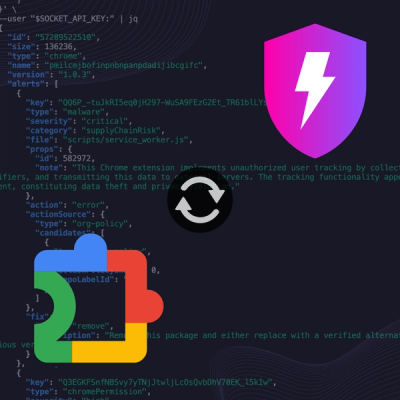
Product
Announcing Precomputed Reachability Analysis in Socket
Socket’s precomputed reachability slashes false positives by flagging up to 80% of vulnerabilities as irrelevant, with no setup and instant results.
@azure/communication-chat
Advanced tools
Azure client library for Azure Communication Chat services
Azure Communication Services for Chat lets developers add chat capabilities to their app. Use this client library to manage chat threads and their users, and send and receive chat messages.
Read more about Azure Communication Services here
npm install @azure/communication-chat
To use this client library in the browser, first you need to use a bundler. For details on how to do this, please refer to our bundling documentation.
In rollup.config.js, add following customized name exports in cjs plugin.
cjs({
namedExports: {
events: ["EventEmitter"],
"@azure/communication-signaling": ["CommunicationSignalingClient", "SignalingClient"],
"@opentelemetry/api": ["CanonicalCode", "SpanKind", "TraceFlags"]
}
})
A chat conversation is represented by a thread. Each user in the thread is called a chat participant. Chat participants can chat with one another privately in a 1:1 chat or huddle up in a 1:N group chat. Users also get near-real time updates for when others are typing and when they have read the messages.
ChatClient is the primary interface for developers using this client library. It provides asynchronous methods to create and delete a thread.
ChatThreadClient provides asynchronous methods to do the message and chat participants operations within the chat thread.
Use resource url and user access token to initialize chat client.
import { AzureCommunicationTokenCredential } from "@azure/communication-common";
import { ChatClient } from "@azure/communication-chat";
// Your unique Azure Communication service endpoint
const endpointUrl = "<ENDPOINT>";
const userAccessToken = "<USER_ACCESS_TOKEN>";
const tokenCredential = new AzureCommunicationTokenCredential(userAccessToken);
const chatClient = new ChatClient(endpointUrl, tokenCredential);
Use the createThread method to create a chat thread.
createChatThreadRequest is used to describe the thread request:
topic to give a thread topic;createChatThreadOptions is used to set the optional params to create the thread:
participants to list the chat participants to be added to the thread;idempotencyToken to specify a repeatable requestcreateChatThreadResult is the result returned from creating a thread. It contains a chatThread which is the thread that was created, as well as an errors property which will contain information about invalid participants if they failed to be added to the thread.
import { AzureCommunicationTokenCredential } from "@azure/communication-common";
import { ChatClient } from "@azure/communication-chat";
// Your unique Azure Communication service endpoint
const endpointUrl = "<ENDPOINT>";
const userAccessToken = "<USER_ACCESS_TOKEN>";
const tokenCredential = new AzureCommunicationTokenCredential(userAccessToken);
const chatClient = new ChatClient(endpointUrl, tokenCredential);
const createChatThreadRequest = {
topic: "Hello, World!",
};
const createChatThreadOptions = {
participants: [
{
id: { communicationUserId: "<USER_ID>" },
displayName: "<USER_DISPLAY_NAME>",
},
],
};
const createChatThreadResult = await chatClient.createChatThread(
createChatThreadRequest,
createChatThreadOptions,
);
const threadId = createChatThreadResult?.chatThread?.id;
The ChatThreadClient will allow you to perform operations specific to a chat thread, like update the chat thread topic, send a message, add participants to the chat thread, etc.
You can initialize a new ChatThreadClient using the getChatThreadClient method of the ChatClient with an existing thread id:
import { AzureCommunicationTokenCredential } from "@azure/communication-common";
import { ChatClient } from "@azure/communication-chat";
// Your unique Azure Communication service endpoint
const endpointUrl = "<ENDPOINT>";
const userAccessToken = "<USER_ACCESS_TOKEN>";
const tokenCredential = new AzureCommunicationTokenCredential(userAccessToken);
const chatClient = new ChatClient(endpointUrl, tokenCredential);
const chatThreadClient = chatClient.getChatThreadClient("<threadId>");
Use sendMessage method to sends a message to a thread identified by threadId.
sendMessageRequest is used to describe the message request:
content to provide the chat message content;sendMessageOptions is used to describe the operation optional params:
senderDisplayName to specify the display name of the sender;type to specify the message type, such as 'text' or 'html' ;sendChatMessageResult is the result returned from sending a message, it contains an ID, which is the unique ID of the message.
import { AzureCommunicationTokenCredential } from "@azure/communication-common";
import { ChatClient, SendMessageOptions } from "@azure/communication-chat";
// Your unique Azure Communication service endpoint
const endpointUrl = "<ENDPOINT>";
const userAccessToken = "<USER_ACCESS_TOKEN>";
const tokenCredential = new AzureCommunicationTokenCredential(userAccessToken);
const chatClient = new ChatClient(endpointUrl, tokenCredential);
const chatThreadClient = chatClient.getChatThreadClient("<threadId>");
const sendMessageRequest = {
content: "Hello Geeta! Can you share the deck for the conference?",
};
const sendMessageOptions: SendMessageOptions = {
senderDisplayName: "Jack",
type: "text",
};
const sendChatMessageResult = await chatThreadClient.sendMessage(
sendMessageRequest,
sendMessageOptions,
);
const messageId = sendChatMessageResult.id;
With real-time signaling, you can subscribe to listen for new incoming messages and update the current messages in memory accordingly.
import { AzureCommunicationTokenCredential } from "@azure/communication-common";
import { ChatClient } from "@azure/communication-chat";
// Your unique Azure Communication service endpoint
const endpointUrl = "<ENDPOINT>";
const userAccessToken = "<USER_ACCESS_TOKEN>";
const tokenCredential = new AzureCommunicationTokenCredential(userAccessToken);
const chatClient = new ChatClient(endpointUrl, tokenCredential);
// open notifications channel
await chatClient.startRealtimeNotifications();
// subscribe to new notification
chatClient.on("chatMessageReceived", (e) => {
console.log("Notification chatMessageReceived!");
// your code here
});
Alternatively you can retrieve chat messages by polling the listMessages method at specified intervals.
import { AzureCommunicationTokenCredential } from "@azure/communication-common";
import { ChatClient } from "@azure/communication-chat";
// Your unique Azure Communication service endpoint
const endpointUrl = "<ENDPOINT>";
const userAccessToken = "<USER_ACCESS_TOKEN>";
const tokenCredential = new AzureCommunicationTokenCredential(userAccessToken);
const chatClient = new ChatClient(endpointUrl, tokenCredential);
const chatThreadClient = chatClient.getChatThreadClient("<threadId>");
for await (const chatMessage of chatThreadClient.listMessages()) {
// your code here
}
Once a thread is created, you can then add and remove users from that thread. By adding users, you give them access to be able to send messages to the thread. You will need to start by getting a new access token and identity for that user. The user will need that access token in order to initialize their chat client. More information on tokens here: Authenticate to Azure Communication Services
import { AzureCommunicationTokenCredential } from "@azure/communication-common";
import { ChatClient } from "@azure/communication-chat";
// Your unique Azure Communication service endpoint
const endpointUrl = "<ENDPOINT>";
const userAccessToken = "<USER_ACCESS_TOKEN>";
const tokenCredential = new AzureCommunicationTokenCredential(userAccessToken);
const chatClient = new ChatClient(endpointUrl, tokenCredential);
const chatThreadClient = chatClient.getChatThreadClient("<threadId>");
const addParticipantsRequest = {
participants: [
{
id: { communicationUserId: "<NEW_PARTICIPANT_USER_ID>" },
displayName: "Jane",
},
],
};
await chatThreadClient.addParticipants(addParticipantsRequest);
Similar to above, you can also remove users from a thread. In order to remove, you will need to track the IDs of the participants you have added.
import { AzureCommunicationTokenCredential } from "@azure/communication-common";
import { ChatClient } from "@azure/communication-chat";
// Your unique Azure Communication service endpoint
const endpointUrl = "<ENDPOINT>";
const userAccessToken = "<USER_ACCESS_TOKEN>";
const tokenCredential = new AzureCommunicationTokenCredential(userAccessToken);
const chatClient = new ChatClient(endpointUrl, tokenCredential);
const chatThreadClient = chatClient.getChatThreadClient("<threadId>");
await chatThreadClient.removeParticipant({ communicationUserId: "<MEMBER_ID>" });
Subscription to events realTimeNotificationConnected and realTimeNotificationDisconnected allows you to know when the connection to the call server is active.
import { AzureCommunicationTokenCredential } from "@azure/communication-common";
import { ChatClient } from "@azure/communication-chat";
// Your unique Azure Communication service endpoint
const endpointUrl = "<ENDPOINT>";
const userAccessToken = "<USER_ACCESS_TOKEN>";
const tokenCredential = new AzureCommunicationTokenCredential(userAccessToken);
const chatClient = new ChatClient(endpointUrl, tokenCredential);
// subscribe to realTimeNotificationConnected event
chatClient.on("realTimeNotificationConnected", () => {
console.log("Real time notification is now connected!");
// your code here
});
// subscribe to realTimeNotificationDisconnected event
chatClient.on("realTimeNotificationDisconnected", () => {
console.log("Real time notification is now disconnected!");
// your code here
});
Enabling logging may help uncover useful information about failures. In order to see a log of HTTP requests and responses, set the AZURE_LOG_LEVEL environment variable to info. Alternatively, logging can be enabled at runtime by calling setLogLevel in the @azure/logger:
import { setLogLevel } from "@azure/logger";
setLogLevel("info");
In this quickstart you learned how to:
If you'd like to contribute to this library, please read the contributing guide to learn more about how to build and test the code.
FAQs
Azure client library for Azure Communication Chat services
The npm package @azure/communication-chat receives a total of 10,007 weekly downloads. As such, @azure/communication-chat popularity was classified as popular.
We found that @azure/communication-chat demonstrated a healthy version release cadence and project activity because the last version was released less than a year ago. It has 2 open source maintainers collaborating on the project.
Did you know?

Socket for GitHub automatically highlights issues in each pull request and monitors the health of all your open source dependencies. Discover the contents of your packages and block harmful activity before you install or update your dependencies.

Product
Socket’s precomputed reachability slashes false positives by flagging up to 80% of vulnerabilities as irrelevant, with no setup and instant results.

Product
Socket is launching experimental protection for Chrome extensions, scanning for malware and risky permissions to prevent silent supply chain attacks.

Product
Add secure dependency scanning to Claude Desktop with Socket MCP, a one-click extension that keeps your coding conversations safe from malicious packages.